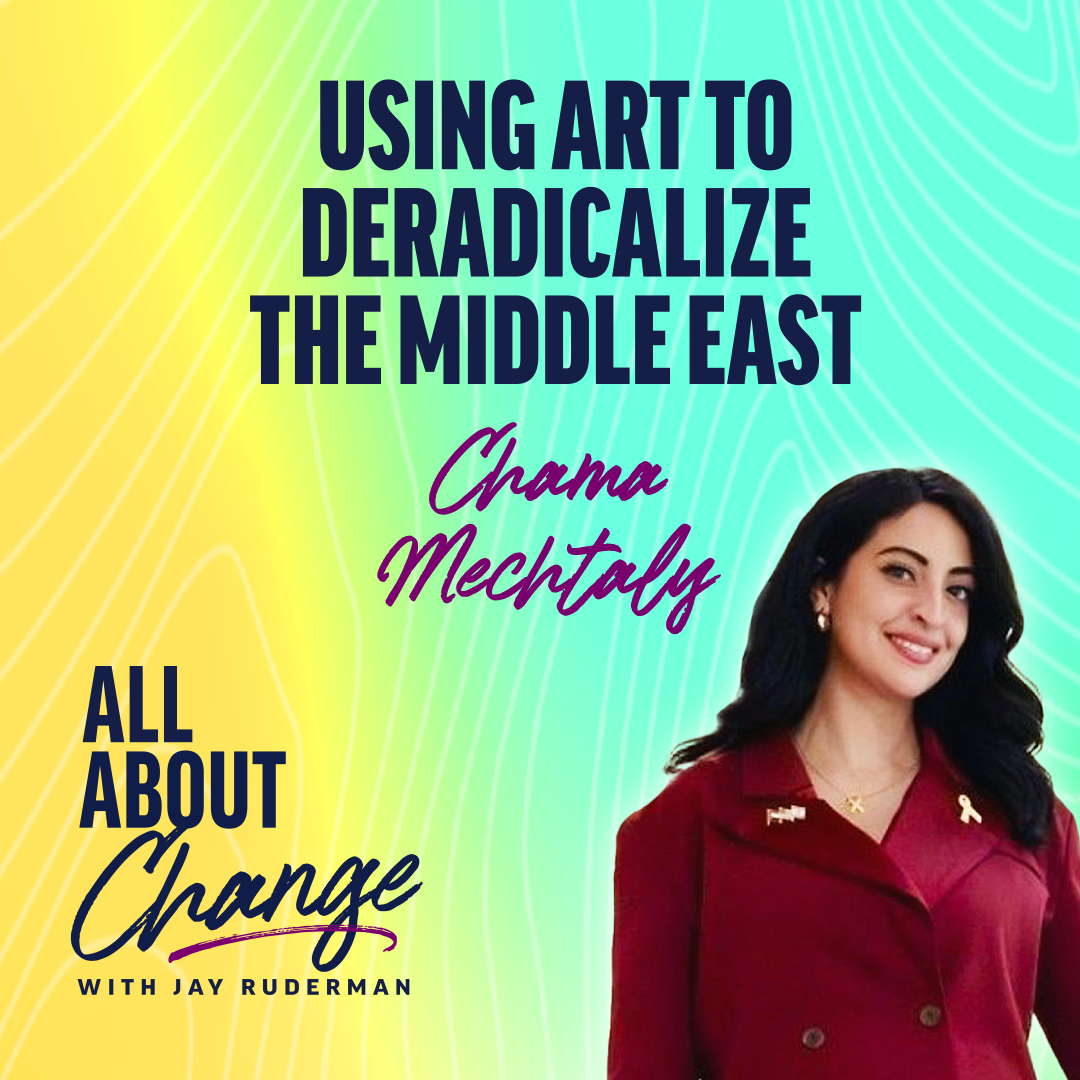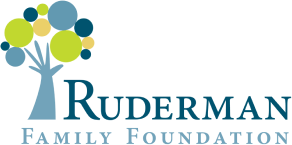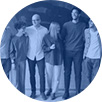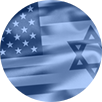
Chama Mechtaly: Using Art to Deradicalize the Middle East
Chama Mechtaly is the Founder of The Emma Lazarus Institute for Liberty and Tolerance, an action tank bridging media and policy gaps between the Middle-East and the Democratic West. She is a policy advisor, public speaker, artist, entrepreneur and activist working in service of conflict transformation, deradicalization and regional integration in MENA and beyond. Chama’s art has been shown across the world, and is the founder of the jewelry brand Moors & Saints.
Jay and Chama discuss Chama’s mixed-religion upbringing in Morocco, art as advocacy, how the reception to Chama’s art shaped her policy goals for the Mena region, and much more.
TRANSCRIPTION
Jay Ruderman:
Welcome to All About Change. Now is a great time to check out my new book about activism, Find Your Fight. You can find Find Your Fight wherever you buy books and you can learn more about it at JRuderman.com. Today my guest is Chama Mechtaly. Chama is a Moroccan Jew from a mixed Jewish-Muslim family. An artist from a young age, she has spent her professional life combining that passion with an interest in international affairs, particularly those related to Israel and the Middle East. She’s now the founder of the Emma Lazarus Institute for Liberty and Tolerance, an action tank, bridging media and policy gaps between the Middle East and the Democratic West. As a visual artist, she has exhibited her work in four continents, including twice at the Jerusalem Biennale. Chama, welcome to All About Change. Chama Mechtaly, thank you so much for being my guest on All About Change.
Chama Mechtaly:
Thank you for having me.
Jay Ruderman:
Chama, I want to talk about growing up for you in Morocco. You come from a mixed family of Muslim and Jewish, and I wanted to ask you about the role that religion played in your life growing up and how that impacted your views as you got older.
Chama Mechtaly:
That’s a great question. So I was born on July 4th in Casablanca, Morocco, 1992. So I grew up in the 90s, early 2000s, until I was 17 years old, really in Casablanca, Morocco. My mother’s from the north of Morocco, my father’s from the south. My mother is Muslim, my father is ethnically Jewish, though grew up very secular and really influenced by French secularism, which we call laïcité. And, for me, religion from an early age was really complicated, obviously. And not so much because of the interfaith story, but because of how I experienced religion in a public space. I grew up at a time when there was an Islamist insurgency that was sweeping through North Africa in the Middle East. And so my experience as a woman in public spaces, especially in a big city like Casablanca, meant constantly facing religious extremism and repression and being told that I am not allowed in certain spaces, I am not supposed to show up in certain spaces.
And it just created this stark difference from my experience in public spaces and my experience at home with my family, with my parents, with my father, who was not setting any boundaries around how I should show up in public spaces or how I should dress up. And, if anything, my parents both really pushed me to do a lot more than sort of the average boy around me. And so my experience with religion was both getting to see the kind of cultural beautiful aspects, the pluralistic aspects to religion, the diversity of religion in the Middle East and North Africa, and the repression of religion when it’s used as an ideology.
Jay Ruderman:
So where did you see or experience the diversity in Morocco?
Chama Mechtaly:
So it was clear from sort of a young age, I would hear stories of Muslim Jewish coexistence and I would hear also stories of longing to the Jewish community. I would hear it specifically from my father’s generation, my mother’s generations. When it comes to mind already, you had decades of essentially anti-Israel, anti-Semitic sentiment that was brewing the background. You had an erasure of Jewish and other Indigenous and Native communities to the region. And so my generation grew up with this idea that they’re only supposed to be Muslim and Arab, and it was a lot harder to actually speak to them about that diversity.
But the generation that was older was really shaped by that coexistence and diversity. And you’d really see it everywhere. I mean, Morocco in particular has a massive Jewish history, and while it might not be so apparent, the moment you start doing a little bit of digging, you see it sort of unravel. And one of my favorite proverbs that specifically Amazigh communities in Morocco say, so the Amazigh communities are the Berbers or the Native communities of North Africa, and they say that if you scratch Moroccan once, you find an Amazigh. If you scratch twice, you find the Jew.
So there’s this recognition that the Indigenous history of the region is very, very deeply Jewish, but it has been essentially erased or lost, that Jewish story has been lost through hundreds of years of essentially Islamist conquest and erasure that was coming in from different invading cultures that were imposing a system of dominance over the Native communities. And so you really see it everywhere, and the more you go venture into the Atlas Mountains, you venture into Amazigh heartland. You see there’s a museum in the south of Morocco that is entirely Jewish and has these artifacts from two thousands of years of Jewish history. My hope after the of peace deals that were taking shape in 2020 and onwards was that we would have a revival in not just the search, but the curiosity, sort of the social cultural curiosity around this beautiful heritage that had been pushed to decide. And hopefully we’ll get back to that place again.
Jay Ruderman:
So you’re growing up in a culture where for a long time there’s been Islamic influence and you, as I understand, went to a public high school and experienced discrimination. How did you learn about the diversity and the history of the country you grew up in?
Chama Mechtaly:
I think I just inherently internalized my difference, and it was affirmed by the reaction of the public, my peers, my teachers, classmates. People would make fun of my last name and know that it doesn’t sound Arabic, doesn’t sound Muslim. So that made me sort of question my identity more. But also I realized that I really felt othered everywhere and in every space that I go to and so much that the first time I actually felt belonging in my life was when I went to college. I went to Brandeis University.
Jay Ruderman:
Like me.
Chama Mechtaly:
No way. That’s amazing.
Jay Ruderman:
There you go.
Chama Mechtaly:
It was really the first time that I felt deep belonging in my life. And I think it was because as a patrilineal Jew, it’s very hard to find belonging in Sephardi Mizrahi spaces, it’s very centralized, also these are communities was very recent traumas, recent experiences of exclusion, exile, and persecution. And so they tend to be more insular. It wasn’t until I got to Brandeis University with that sort of tradition of the American Jewish reform legacy and the deeply embedded values of inclusion where I looked around and I realized, “Oh my God, being a Jew is actually an ethnicity. That’s why I feel how I feel. That’s why I’ve been fighting for Jewish inclusion since I was a kid. That’s why I’ve been fighting for peace in the Middle East since I was a kid.” Right? And so I came to really understand what Jewish identity means through really going on these adventures and experiences and allowing my identity to meet the world and sort of meet the world where it is and kind of negotiating my identity as a result.
But I didn’t feel full integration of my identities until I went to Israel. So when I went to Israel for the first time, that was the second time in my life I felt deep belonging, very, very deep belonging. In Israel you land and you see Hebrew and Arabic in all this public signs. For me, as someone who had fought for the inclusion of Jewish history and Jewish narratives and stories, to see the Magen Davids in public spaces for the first time and not see them be threatened or defaced or damaged in public spaces was so healing for me that I literally broke down when I saw the first Magen David in the pharmacy sign.
And so, in Israel, I really experienced this holistic integration of my identities. And I think if people of the region were able to go and experience Israel and sort of park the stereotypes, the preconceived notions to the side and really experience it for themselves, they would realize that it has become sort of the last stronghold of diversity in the region and actually exposes the beautiful pluralism that has shaped the Middle East and North Africa for thousands of years. Somehow, by a miracle, this very small plot of land was able to actually preserve all of that diversity. And so what happens for a Kurdish person, an Amazigh person, a Druze person going to Israel for the first time and seeing that inclusion and that integration of the diversity of the region, it’s just something calms down in their hearts, a piece of the puzzle integrates into their hearts and they realize, “Oh my goodness, we have been lied to because there are extremist ideologies that are really going after that diversity.”
Jay Ruderman:
You have incorporated intersectionality and interdisciplinarity approach to peace building Jewish inclusion, Arab-Israeli integration. Talk about that work and why it’s important. But also I wanted to ask you, is it possible with what is built up in the region with Islamic fundamentalism, which opposes all of that, how does your work face reality and do you face discrimination threats to you? How do you do your work in the face of reality in the region?
[French language 00:11:22].
Chama Mechtaly:
Sure. So that’s a great question. I think, first of all, you asked how I integrate intersectionality into this work. I think there’s no other way, and I think part of it is as someone who went to Brandeis, you understand, I carry that sort of legacy, but there’s a reason I went to Brandeis in the first place. I painted a series of Amazigh Jewish women when I was a teenager and took them everywhere for exhibitions and acts of essentially resistance and resilience and really showcasing those stories that were pushed to the side.
And I called them the triple minority status woman. I didn’t have that language of intersectionality, but I just knew that they navigated three times those levels of oppression and marginalization. And so of course their stories are not to be found anywhere. When it comes to sort of the realistic, pragmatic applicability of this in this backdrop of fundamentalist, jihadist ideology that really seeks to wipe out all of this difference. What I truly, fundamentally, believe and work for is setting a foundation for regional integration through de-radicalization, through countering extremism and specifically the de-radicalization of culture. And that’s why I founded the Emma Lazarus Institute.
Jay Ruderman:
So I want to bring you back to 2015 and you did a piece of artwork that was very controversial. And in the end you decide to remove the piece of artwork from the exhibition. Can you talk about that story, what happened and how that shaped your view of where you were and what was happening in the region?
Chama Mechtaly:
Yes. So I didn’t remove it. It was not according to my free will, but it was actually removed by the Ministry of Interior and then by the police. But to explain to you what happened, it was June, 2015, I had an exhibition at the heart of Casablanca, Morocco. And this was after I had done many exhibitions abroad, especially in the United States, and this was going to be my solo exhibition in Morocco. So I’m getting a lot of commentary and feedback and attention. And I was actually on my way to a radio show around 12:00 P.M., where everyone’s driving back home, so everyone’s tuning in, and it was a live radio show and they asked why it was the first time I was doing the solo exhibition after doing many exhibitions abroad. And I said, “It’s not the lack of trying. I keep trying and I keep getting censored. In fact, on my way to you, I received a call from the Ministry of Interior who threatened to shut it down, who said that they’re going to take me to jail for what they call the defamation of a national symbol because my work had Magen Davids in it.”
And essentially they threatened to find me and take me to jail and said that if I put back even an image of the painting on the wall, that I would face those serious repercussions. And there were undercover cops outside of the exhibition, inside the exhibition, and actual cops outside of the exhibition. And so it was this very, very tense environment, and this is why I needed to explain to the audience sort of the political complexity of the country. Now, after the Arab Spring 2011, the Muslim Brotherhood affiliate political party in Morocco was able to consolidate power, was voted on by popular votes.
So they headed the government at the time, and they won two times after the first time. So they were in power over a long period of time, and that enabled them to really deepen their grip on the politics and the social and cultural dynamics of the country. So all of a sudden you look around and most women are wearing the hijab. When you walk into parliament, all women are wearing the hijab. And so they started really shifting the culture of the country and repressing all civil liberties, coming after the artists, the journalists, et cetera. Now that exhibition really kind of put me on the map of all the sort of radicals and fundamentalists.
I was receiving death threats on a regular basis. And at the same time as this was happening, and when I started to realize, “My goodness, they have become really powerful in North Africa and Morocco in particular.” I started seeing this breath of fresh air coming from the east, from the Gulf in particular. And I became really curious about what was going to happen in the Gulf because I started seeing them implementing more inclusive practices, using more inclusive rhetoric, and looking towards the Jewish community in Israel. And that’s why I moved to the UAE in 2016.
Jay Ruderman:
So just for the audience’s benefit, and hopefully we’ll throw a picture in there, the art in question was a Moroccan flag with instead of the traditional star, a Jewish star in the middle with some other images of Native culture. That was what was offensive to the authorities.
Chama Mechtaly:
Yeah, so initially they said that it was all offensive because there were Magen Davids in my portraits of women and some of my more abstract work that was informed and inspired by Amazigh rugs and Amazigh Jewish artistry and craftsmanship. But I essentially negotiated with the authorities and I said, “There’s no way I’m going to bring down the other works.” But they basically sort of doubled down on the pressure and said if I were to leave the Moroccan flag, I would immediately go to jail. And it became actually a really powerful symbol because when you walked into the exhibition, you saw the name of the artwork, but no artwork. Which is essentially where we find ourselves in the Middle East and North Africa, that question around identity as a whole, but specifically Indigenous identities and Jewish identities as part of the Indigenous landscape of the region is totally erased, totally absent.
And the artwork was actually a nod to how the Moroccan flag used to look like. So it was a red flag, red banner with a green Magen David, and it used to have this Magen David up until 1927. And the story says the flag was changed by this French general, Marshal Lyautey, to reflect a five pillar star instead of a six pillar star. And the artwork, if you look a little bit deeper, if you get a little bit closer, you see that it has a three languages that have really defined our culture as North Africans and as Moroccans. One is Tifinagh, which is the language of the Amazigh people, and it is now recognized part of the constitution.
The second language is obviously Arabic, which is part of the culture of Middle East and North Africa. And the third language is most definitely Hebrew. And so the artwork had Hebrew, Arabic, Tifinagh scripts woven together with the Magen David in the center, and the Magen David itself is really kind of showcasing all of these beautiful Amazigh symbolism that also tell a story of deep indigenous legacy. And that puts forward the centrality of Jewish indigeneity when we talk about Indigenous communities of North Africa and the Middle East. So that was the artwork that threatened so many.
Jay Ruderman:
Can you talk about some of your successes in terms of the work that you’ve done in terms of integration and acceptance of Jewish culture? What have you been able to do to move the needle forward?
Chama Mechtaly:
So even when I was in Morocco, I worked briefly at the Parliament in the Division of International Affairs. I put up events interpreting the reforms of the constitution in 2011, which declared for the first time that Jewish identity is a core component of Moroccan identity, and that’s actually really major and something I wish that the west would see a little bit more and understand that model a little bit more. So I put up events interpreting that part of the constitution, what it means to teach Hebrew in national schools and national curricula. I hosted many, many, many summits and events and discussions and panels on the Israeli, Moroccan, Israeli UAE, Israeli Bahraini relationships. I put up the first exhibition between the UAE and Israel in Jerusalem in 2021, shortly after the Abraham Accords. And it was incredible. It reverberated across the region. We had diplomats from every embassy representing the Middle East in Jerusalem, attending many ambassadors.
The UK Minister of State had tweeted about it, celebrating this exhibition and telling people, “This is what we need to see more of,” because fundamentally it’s really about shifting cultures as well and creating this sort of cultural framework through which people understand the political shift because you can’t just all of a sudden show up and say, “Now we have peace.” Other wins were basically setting up summits and spaces of dialogue where we totally witnessed the complete transformation of people.
One of these initiatives that I do now as part of the Emma Lazarus, in partnership with the Abraham Accords Institute is we put up these deradicalization summits and we bring media personalities, people who woke up to extremism in the region recently and are trying to develop ideas, we put them together with deradicalization and counter extremism, experts who have been in the field on the ground looking at the ideology, looking at the philosophies that underlay the ideology for decades. And sort of allowing them to share knowledge, share best practices so that whatever the intellectuals develop is not just read by one or two people but is actually scaled and whatever that is developed by the media personalities and the social media influencers and the activists is informed by decades of research and best practices. And so that’s really where I thrive, is this convergence of policy and culture towards deeper deradicalization in the region because, again, this is the only way to pragmatically set the stage for sustainable peace.
Jay Ruderman:
So I want to focus on your art and how you weave your art into activism. And recently on the show, Eli Beer runs United Hatzalah in Israel. Talk to me about the volunteerism of Muslims and Jews together for the common good. Your jewelry line, Moors & Saints is meant to promote religious tolerance. Tell me about art jewelry and how that helps you promote your activism.
Chama Mechtaly:
So it’s twofold. One, when you have ideologies that take away the right to sing in public, that take away really beauty that repress women’s freedoms, it’s all because they’re actually going after culture. So if they can completely essentialize, reduce culture to what they see fit, which is very clearly stated, a return to sort of a purest version of Islam, which really is not a purest version, it’s a fundamentalist interpretation that has constantly been challenged throughout the Muslim world and throughout hundreds of years. But by stripping away these avenues of culture, you are stifling, obstructing innovation, the ability to imagine. Because really what is radicalism and extremism? It is an attack on the imagination. When someone tells you you can only be this or that, nothing in between, they are suppressing your very ability to imagine a different reality.
First, it is a kind of a reclaiming of the culture and the diversity of the region. And second, I was pushed into it because even though I think I’ve always been an artist and I’ve always as a child always painted and drew and created things, but I was pushed into it in the sense that when I started with political activism in my schools growing up, I was clearly told that I had no right to speak. And so my automatic reaction was, “I’m going to create a very safe space for people to actually understand that they’ve been lied to in school, that they’ve been manipulated, that they have not been told the full story.” And when I created an artwork or a jewelry collection that is so beautiful, you can’t actually look away. It commands you to look and it creates this immediate intimacy because it also tells your story and you are able to see yourself in the product or in the painting. And so you’ll have no choice but to actually face that history and that diversity that we just didn’t have spaces for before.
Jay Ruderman:
So your art is very beautiful, and when you’re in the UAE, when you’re in Bahrain, is your art able to be seen? Do you feel that you have more ability to show a diverse piece of art there than in Morocco or in other places in North Africa and the Middle East?
Chama Mechtaly:
That’s a brilliant question.
Hi, my name is Chama Mechtaly and I’m the founder and creative director of Moors & Saints, which is a startup incubated here at IN5 Design. So Moors & Saints is a fine jewelry company that offers products inspired by Moorish architecture and Moorish design. And what we do is we map where Moorish architecture kind of started, so in Andalusia and the Maghreb region and how it traveled across the world, so reaching as far as Mexico in the west or India in the east. And we really try to source out places that have this kind of architecture across different religions. So IN5 believed in me from day one, and I had a lot of fun pitching Moors & Saints for the committee and had a lot of fun with the application process, which to be fair was very much hassle free and pretty straightforward. And IN5 also offers the cheapest rated incubate and to start a business in Dubai. So that was a no-brainer for me, and I’m sure for any young aspiring entrepreneur.
So the reason why I started Moors & Saints was because when I showed up in UAE in 2016, I looked everywhere, I asked everyone and I said, “Is it okay if I show these paintings that showcase Jewish minority communities from Mizrah, from the east?” And I was told that the community’s still not ready for it, and as long as there is no sort of green light from the top that it would be very difficult to do that kind of thing. The green lights came with first the UAE’s Year of Tolerance in 2019, and that’s what allowed me to launch Moors & Saints at a really massive design fair called the Dubai Design Fair that happens in the fall.
And that draws in people from all over the globe with the best design innovation. And I would have people kind of coming into the pop-ups and the activations and they would see collection covered in Magen Davids in jewelry, sacred architectural jewelry inspired by Moorish design, but embedded with Magen Davids. And they would say, “What’s this doing here? Why do you have the Israeli flag on the jewelry?” And I would say, “Well, I’m so glad you asked. This is a Magen David. This piece is actually inspired by a mosque where you find the Magen David ingrained it on stone in the courtyard of the mosque in Egypt, and the mosque was built a thousand years ago by a Jewish architect from Iraq.”
And so it just totally destroys all of their ideas about the Jew or about the other. And now all of a sudden, “What do you mean Jews were here thousands of years ago and were instrumental in building Muslim civilization?” It’s not always easy, of course, and I tend to sort of market segments as much as I can because ultimately I want that message to resonate, to land. And I want culture to be deradicalized, and I want Jews to be understood as Indigenous to the region and Israel as a core part of the region that is never going to go anywhere. It’s really because of that that I kind of tweak my approach and it becomes really hard and difficult to answer the basic question of, “What do you do for a job?”
Because given my experiences in the spaces in which I was born and grew up and had formed my formative years, I’ve had to kind of carve out these different professional identities. And so I thought, “Okay, well, we’re just going to have to be entrepreneurial and create a small business with deep social impact.” And so these are the things that are really lost on the West in particular when they think of the Middle East, because there’s a lot of media manipulation and there’s just a lot of glossing over the specificities of the Middle East, and it tends to create these gaps in consciousness.
And those gaps only further the goals of the extremist organizations because it hinders the very ability to actually engage with the Middle East and with the different countries of the Middle East, not just normal countries, essentially normalizing not just Israel, but all of the other countries that make up the region. And so this is why I’m also very, very, very firmly against any organization that claims to work for peace, but is actually calling for the boycotts of not just Israel, but other countries in the region that they see normalizing with Israel, the Abraham Accord countries, because they don’t want those avenues of dialogue. And so that rupture and communication really helps them create even more and fertilize more extremism in Western society.
Jay Ruderman:
I like what you’re doing as shifting and approaching different things in order to try to get the word out there and show people the reality, and come up against a really, really strong and dangerous philosophy that’s in the region. So I give you a lot of credit. I hope that you are keeping safe because I think the threats out there are real. I’ve learned a lot from you, and I appreciate you being my guest today on All About Change.
Chama Mechtaly:
Thank you so much. Really pleasure to meet you.
Jay Ruderman:
Thank you for being part of the All About Change community. We aim to spark ideas for personal activism, helping you find your pathway to action beyond awareness. So thank you for investing your time with us, learning and thinking about how just one person can make the choice to build a community and improve our world. I believe in the power of informed people like you to drive real change, and I know that what we explore today will be a tool for you in that effort. All right, I’ll see you in two weeks for our next conversation, but just one small ask, please hit subscribe and leave us a comment below. It lets us know that you value this content and it supports our mission to widely share these perspectives. If you’re looking for more inspiration, check out this next video. I chose it for you and I know you’re going to enjoy it. I’m Jay Ruderman. Let’s continue working towards meaningful change together.
Today’s episode was produced by Tani Levitt and Mijon Zulu. To check out more episodes or to learn more about the show, you can visit our website Allaboutchangepodcast.com. If you like our show, spread the word, tell a friend or family member, or leave us a review on your favorite podcasting app. We really appreciate it. All About Change is produced by the Ruderman Family Foundation.
Stay Included
To stay up to date on our most recent advocacy efforts, events and exciting developments, subscribe to our newsletter and blog!















